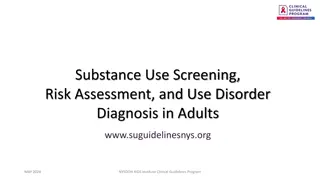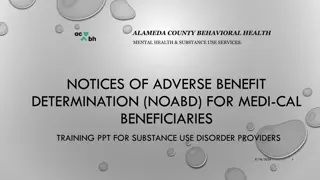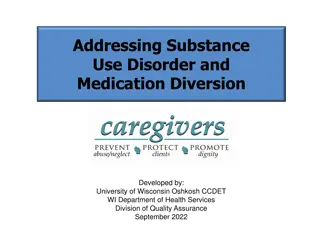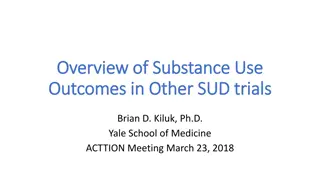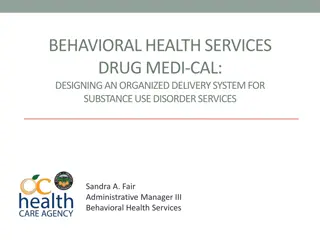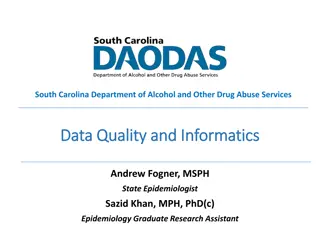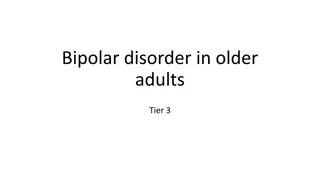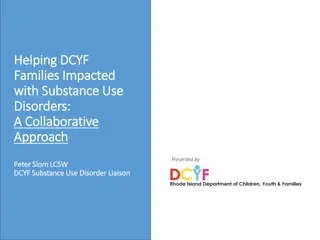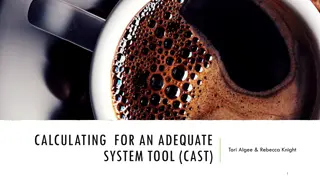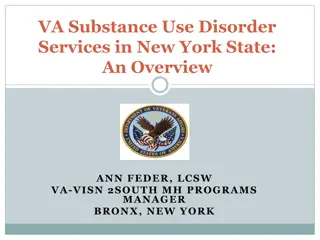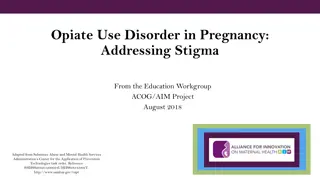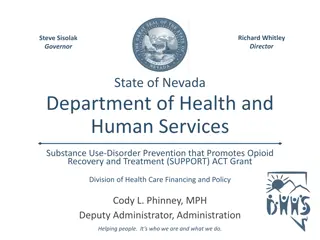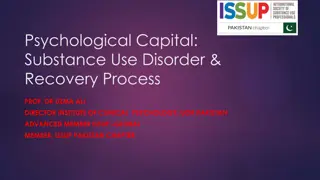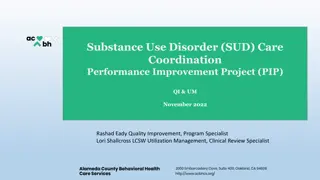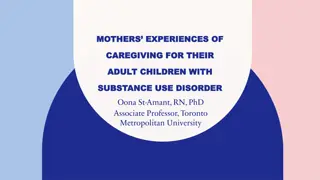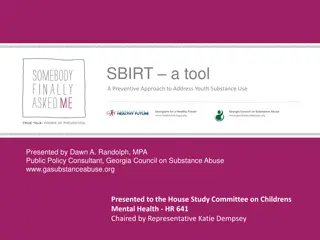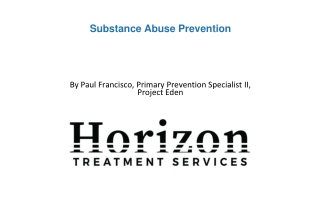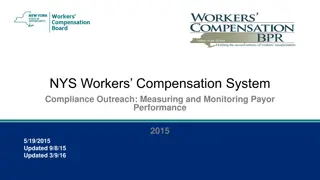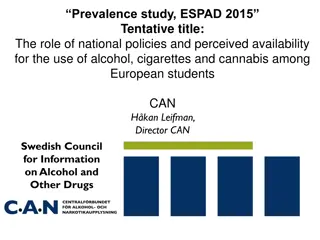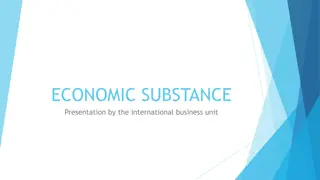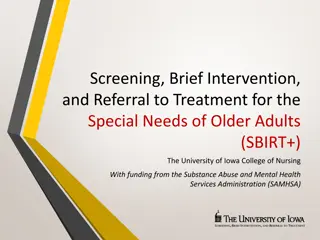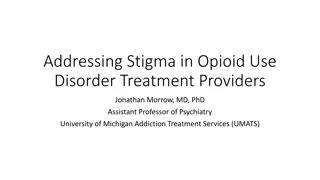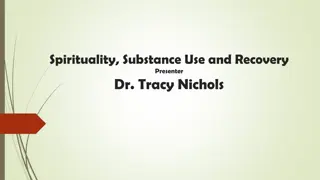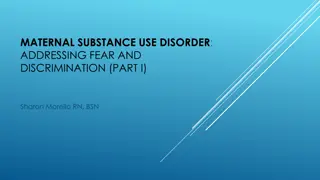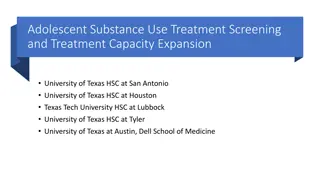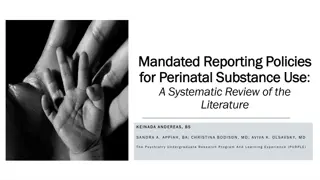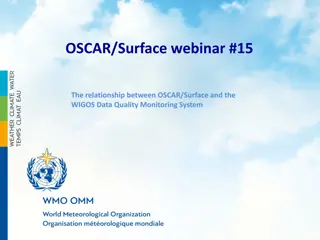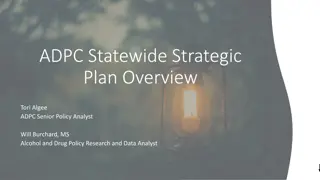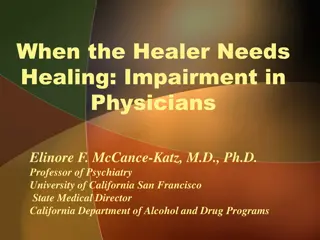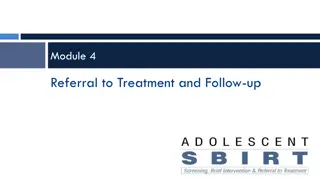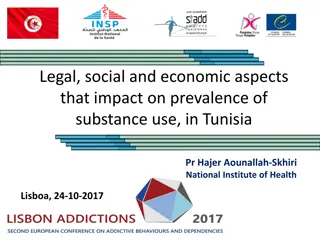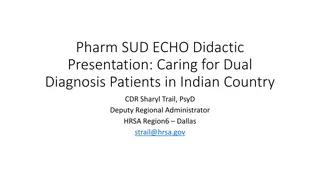Enhancing Timeliness and Quality in Substance Use Disorder Services
Focus on improving performance and quality in substance use disorder services through timely admissions, reducing exceptions, and utilizing existing data collection mechanisms effectively. Emphasize reporting on performance indicators for better quality improvement and address challenges in wait times, provider details, demographics, and substances involved. Demonstrate improvements in performance processes and admissions accountability for better overall treatment outcomes.
Download Presentation

Please find below an Image/Link to download the presentation.
The content on the website is provided AS IS for your information and personal use only. It may not be sold, licensed, or shared on other websites without obtaining consent from the author. Download presentation by click this link. If you encounter any issues during the download, it is possible that the publisher has removed the file from their server.
E N D
Presentation Transcript
TIMELINESS TO SUBSTANCE USE DISORDER SERVICES AND TREATMENT BH TEDS Solution 9/16/2024 INDICATOR #2B BH TEDS SOLUTION 1
DIRECTIVES FOR NEW OR AMENDED PERFORMANCE INDICATORS CMS and HSAG advised the Administration on the following: Focus of performance indicators should be on performance and quality improvement Current high scores shows that indicators are not informing quality improvement Need to: Reduce or eliminate exceptions and exclusions Abandon 95% normative standards created by edict rather than observation Utilize existing data collection mechanisms to every extent possible (Encounters, BH TEDS, Critical Incidents, etc.) INDICATOR #2B BH TEDS SOLUTION 9/16/2024 2
USING BH TEDS WITH 2B OR (NOT) 2B THAT IS THE QUESTION Without Using BH TEDS Using BH TEDS A Records Reported Wait Times for Each Admission (Statistical Analysis) No Yes Provider Level Detail No Yes Proximity (County of Residence to County of Provider) No Yes Demographics (Age, Gender, Race) No Yes Substances Involved (Opiates vs. Methamphetamines vs. Alcohol) No Yes Observe Improvement Inside 14- Day Window (See next slides) No Yes 9/16/2024 INDICATOR #2B BH TEDS SOLUTION 3
DEMONSTRATING PERFORMANCE OR PROCESS IMPROVEMENT By reporting aggregate counts, numerator & denominator, within 14 days: Mean and median for time to treatment are unobservable 13-day wait times are treated equally to 1-day wait times Improvements of wait times within 14 days are masked For example, an improvement of moving from 11 day to 2 days will not be detected. By using Time to Treatment already reported in BH TEDS one can: show improvement in median or mean wait times, even if the 14-day percentages remain effectively unchanged factor in all efforts to improve wait times, not just those from outside 14 days but also inside it observe such things as percentage of admissions on the same day as the request. 14-day window can elevate mediocrity and mask excellence 9/16/2024 INDICATOR #2B BH TEDS SOLUTION 4
BH TEDS SUBSTANCE USE DISORDER ADMISSIONS REPORTABLE ADMISSIONS For this indicator, BHDDA will count the number of Admissions for the quarter. Persons are admitted to each, distinct LARA-licensed site Each provider will be held accountable for timely admissions, not just the one that happens to take place first chronologically Failed Hand-offs from one provider to the next, based on reported Reasons for Discharge of Transfer/Continuing, occur in nearly 40% of SUD episodes when a new provider is involved. 9/16/2024 INDICATOR #2B BH TEDS SOLUTION 5
OBSERVATIONS ON BH-TEDS AND FEDERAL TIME TO TREATMENT FIELD Time to Treatment has been reported on all SUD TEDS admissions since 1992 1.45 million SUD TEDS records have this reported since FY2000 Federally-required field that Michigan is held accountable for completeness and reasonableness in our SAMHSA award agreement BH TEDS definition now matches 2B Indicator definition, which no longer includes exceptions or exclusions. Using BH TEDS is consistent with the goal/directive to use existing data collection sources whenever possible 9/16/2024 INDICATOR #2B BH TEDS SOLUTION 6
BENEFITS FROM USING BH TEDS Eliminate redundant reporting Simplify your reporting task for this Indicator Provide additional information to facilitate quality improvement efforts Evaluate timeliness at each LARA-licensed SUD provider Reinforce accurate BH TEDS reporting in field A013 (as stipulated in the SAMHSA Agreement with Michigan) 9/16/2024 INDICATOR #2B BH TEDS SOLUTION INDICATOR #2B BH TEDS SOLUTION 7
INDICATOR #NEW 2B Current contract language for 2020 The percentage of new persons during the quarter receiving a face-to-face service for treatment or supports within 14 calendar days of a non-emergency request for service for persons with Substance Use Disorders. No Standard for 1st year of implementation will use information to determine baseline. Proposed approach for using BH TEDS to satisfy the requirements of this indicator .. 9/16/2024 INDICATOR #2B BH TEDS SOLUTION INDICATOR #2B BH TEDS SOLUTION 8
TIME TO TREATMENT BH TEDS (A013) Definition from BH TEDS Coding instructions: Date of 1st face-to-face service (SUD treatment service); minus Date of 1st contact/request for service equals Time to treatment; or, (Date of 1st billable, non- brief-screening (H0002) face-to-face service) (Date of 1st contact/request for service) = Time to Treatment. 9/16/2024 INDICATOR #2B BH TEDS SOLUTION 9
1. 2. 3. # of New Persons Who Requested and Were Approved for SUD Treatment or Supports # of Persons from column 1 Receiving a Service for Treatment or Supports within 14 calendar days of First Request % of Persons Requesting a Service who Received Treatment or Supports within 14 Days. Contract Language X1 = X1a +X1b Y1 Y1/X1 X1b. Expired Request: All SUD approved service requests during the quarter for which there is no BHTEDS admission record. X1a. The count of BH TEDS SUD Admission records (Client Transaction Type = A) for the quarter. Based on the BHTEDS Time to Treatment field for Admissions counted in X1a. BH TEDS Methodology BHDDA calculations PIHP calculation 9/16/2024 INDICATOR #2B BH TEDS SOLUTION INDICATOR #2B BH TEDS SOLUTION 10
KEYS POINTS - TO SUMMARIZE BH TEDS Methodology The BH TEDS field Time to Treatment will be used by BHDDA to determine whether a service is provided within 14 days of the request. PIHPs will submit expired requests to the state, outside of BH TEDS reporting. The BH TEDS Admissions and the count of expired requests will be summed for a total count of requests (the denominator, X1). The number of requests resulting in a service within 14 days will be divided by the total number of requests to calculate the percentage receiving a service within 14 days of the request. 9/16/2024 INDICATOR #2B BH TEDS SOLUTION INDICATOR #2B BH TEDS SOLUTION 11
ANOTHER WAY TO LOOK AT IT NEED TO DELINEATE THREE POSSIBLE OUTCOMES 1. Timely Admission BH TEDS Admission with a Time to Treatment within 14 days of request. 2. Untimely Admission BH TEDS Admission with a Time to Treatment outside of 14 days of request. 3. Expired Request Approved Request that does not result in an Admission. Will be reported by the PIHP outside of BH TEDS reporting process. SUMThese three outcomes will be added together to create the total or the denominator, Column #1 9/16/2024 INDICATOR #2B BH TEDS SOLUTION 12
PERFORMANCE INDICATOR INSTRUCTIONS IMPLEMENTATION Contract language: Cases selected for inclusion in Column 1 are those new persons, both Medicaid and non-Medicaid, who made a non-emergency request and were authorized for an SUD service during the quarter. Cases selected for inclusion in Column 2 are those in Column 1 for which the service for treatment or supports took place within 14 calendar days following the first request. 9/16/2024 INDICATOR #2B BH TEDS SOLUTION INDICATOR #2B BH TEDS SOLUTION 13
Terms to Address BH TEDS Methodology . 1. Include all Coverages 6. During the quarter, reporting quarter 2. Definition of a Request 7. Non-emergency 3. Determining Request Date 8. Expired Requests 4. Reporting time to treatment in BH TEDS 9. Counting Expired Requests 5. Counting BH TEDS Admissions 10. Expired Requests - Counting Days from Request New PIHP Tasks BHDDA Task INDICATOR #2B BH TEDS SOLUTION INDICATOR #2B BH TEDS SOLUTION 9/16/2024 14
POPULATIONS Include all coverages Medicaid Healthy Michigan Block Grant General Fund Individuals covered under the Medicaid autism benefit will be included. 9/16/2024 INDICATOR #2B BH TEDS SOLUTION 15
DEFINITION OF A REQUEST Definition of Request: The initial telephone or walk-in request to a provider for non-emergency services by the individual, parent of minor child, legal guardian, referral source (including other SUD providers) A request occurs when: 1. The person or someone on their behalf makes a request at that provider. And 2. The person has been approved for SUD treatments and supports at that provider. 9/16/2024 INDICATOR #2B BH TEDS SOLUTION INDICATOR #2B BH TEDS SOLUTION 16
DETERMINING THE DATE OF REQUEST Example #1: If date of request and date for approval for services are not on the same day: If the request date is 3/31/2020 The approval date is 4/1/2020 The request date is 3/31/2020. 9/16/2024 INDICATOR #2B BH TEDS SOLUTION INDICATOR #2B BH TEDS SOLUTION 17
DETERMINING DATE OF REQUEST (CONT) Example #2: Person difficult to reach after making request via phone, the date of the person s first request is the request date. 1/1/2020 The person calls for the first time and leaves a message, with name and call-back information, requesting services. 1/1/2020 The access center or provider calls the person back, is unable to reach them but leaves a message. 1/15/2020 the person calls back to request services and receives approval for SUD services. The request date is 1/1/2020. Important to note the request starts once the person provides their name and contact information. INDICATOR #2B BH TEDS SOLUTION 9/16/2024 INDICATOR #2B BH TEDS SOLUTION 18
DETERMINING DATE OF REQUEST (CONT) Example #3: Person receives referral from Provider A to Provider B. The request date is the date that Provider B receives the request to provide services to the person. 2/15/2020 The person starts outpatient services at Provider A 2/21/2020 Provider A contacts Provider B to ask to get the person into residential treatment. 2/23/2020 the person agrees to receive treatment from Provider B. 2/29/2020 the person starts services at Provider B. The request date at Provider B is 2/21/2020. 9/16/2024 INDICATOR #2B BH TEDS SOLUTION INDICATOR #2B BH TEDS SOLUTION 19
DETERMINING DATE OF REQUEST (CONT) Example #4: Person is receiving treatment at a residential facility and receives referral from Provider B to Provider C. The request date is the date that the person is discharged from Provider B. 4/7/2020 The person starts residential treatment at Provider B 4/10/2020 Provider B contacts Provider C to ask to get the person into non-intensive outpatient services. 4/10/2020 the person agrees to receive services from Provider C. 4/14/2020 Person is discharged from Provider B residential facility. 4/15/2020 the person starts services at Provider C. The request date is 4/14/2020 the discharge date. 9/16/2024 INDICATOR #2B BH TEDS SOLUTION INDICATOR #2B BH TEDS SOLUTION 20
REPORTING TIME TO TREATMENT IN BH TEDS Start of SUD Services is the first face-to-face service for SUD treatments or supports at that provider. An assessment (H0001 HF) can be counted as the first service. A screening is considered an administrative function and cannot be counted as a service. 9/16/2024 INDICATOR #2B BH TEDS SOLUTION INDICATOR #2B BH TEDS SOLUTION 21
REPORTING TIME TO TREATMENT IN BH TEDS For reporting Time to Treatment in BH TEDS, the PIHPs should determine the request date as described in previous slides Example #1: The date of the request is 3/31/2020 The date of approval for services is 4/1/2020 Person received first face-to-face service (e.g., H0001 HF) on 4/5/2020. The request date is 3/31/2020 Time to Treatment is the number of days between 3/31/2020 and 4/5/2020 Time to Treatment = 5 days. INDICATOR #2B BH TEDS SOLUTION INDICATOR #2B BH TEDS SOLUTION 9/16/2024 22
FOR PROVIDER A: A BHTEDS ADMISSION RECORD WILL BE REPORTED WITH A SERVICE START DATE OF 4-5-2020 AND TIME TO TREATMENT = 5 DAYS. Initial, Reportable Request 3/31/2020 Approval for SUD services 4/1/2020 SUD Admission 4-5-2020 SUD Provider A 5 Days 9/16/2024 INDICATOR #2B BH TEDS SOLUTION 23
FOR PROVIDER B: A BHTEDS ADMISSION RECORD WILL BE REPORTED WITH A SERVICE START DATE OF 4-1-2020 AND TIME TO TREATMENT = 6 DAYS. FOR PROVIDER C: A BHTEDS ADMISSION RECORD WILL BE REPORTED WITH A SERVICE START DATE OF 4-1-2020 AND TIME TO TREATMENT = 0 DAYS. Initial, Reportable Request 4-1-2020 Approval for SUD services 4-1-2020 SUD Admission 4-7-2020 SUD Provider B 6 Days Approval. Persons stays for appointment 4-1-2020 Initial, Reportable Request 4-1-2020 SUD Admission 4-1-2020 SUD Provider C 0 Days 9/16/2024 INDICATOR #2B BH TEDS SOLUTION 24
Counting BH TEDS Admissions BHDDA calculation SUD Admission records will be counted for the indicator if: The person has never received SUD services from the PIHP. or The person is not receiving services from this SUD provider. That is, the person does not have an open Admission at this provider. or The person was discharged from this SUD provider more than 60 days ago. 9/16/2024 INDICATOR #2B BH TEDS SOLUTION INDICATOR #2B BH TEDS SOLUTION 25
BH TEDS SUBSTANCE USE DISORDER ADMISSIONS REPORTABLE ADMISSIONS BHDDA CALCULATION For this indicator, BHDDA will count the number of Admissions for the quarter. Persons are admitted to each, distinct LARA-licensed site Reminder - The State does not require you to admit and discharge between levels of care at same provider Reporting changes in level of care at the same provider is a PIHP decision. INDICATOR #2B BH TEDS SOLUTION INDICATOR #2B BH TEDS SOLUTION 9/16/2024 26
COUNTING BH TEDS ADMISSIONS REPORTING QUARTER BHDDA will determine the reporting quarter for the BH TEDS Admission based on the BH TEDS Service Start Date. Example #1: The Service Start Date on the Admission Record is 4/5/2020 BHDDA will count this Admission for 3rd quarter 2020. Example #2: The Service Start Date on the Admission Record is 9/30/2020 BHDDA will count this Admission for 4th quarter 2020. INDICATOR #2B BH TEDS SOLUTION INDICATOR #2B BH TEDS SOLUTION 9/16/2024 27
NON-EMERGENCY, NON-URGENT REQUEST Contract Requirement Emergency and urgent requests for SUD services are excluded from this indicator: Pregnant women People determined by the PIHP to need SUD services within 24 to 48 hours. BH TEDS Methodology Pregnant women Whether a women is pregnant is collected on the BH TEDS Admission record. BH TEDS Admissions for pregnant women will be excluded for this indicator. Services needed within 24 to 48 hours Currently there is no information in BH TEDS as to whether the person is determined by the PIHP to need SUD services within 24 to 48 hours. This information will be added to BH TEDS Admission record for 2021. Once information is available these BH TEDS Admissions will be excluded for this indicator. INDICATOR #2B BH TEDS SOLUTION INDICATOR #2B BH TEDS SOLUTION 9/16/2024 28
COUNTING BH TEDS ADMISSIONS NON-EMERGENCY, NON-URGENT REQUEST Pregnant women BHDDA will exclude BH TEDS Admissions for pregnant women for this indicator. Services needed within 24 to 48 hours This information will be reported on the BH TEDS Admission record for 2021 as a new data element. When information is available in 2021, BHDDA will exclude these BH TEDS Admissions for this indicator. INDICATOR #2B BH TEDS SOLUTION INDICATOR #2B BH TEDS SOLUTION 9/16/2024 29
EXPIRED REQUESTS PIHP CALCULATION These are approved requests at an SUD provider that do not result in a BH TEDS Admission. Requests are expired if there is no service from this provider within 60 days of the request date. The PIHP will report the number of requests that expired during the quarter. Will be reported to the State, outside of the BH TEDS reporting process. 9/16/2024 INDICATOR #2B BH TEDS SOLUTION INDICATOR #2B BH TEDS SOLUTION 30
HOW TO COUNT THE NUMBER OF DAYS FROM THE REQUEST EXPIRED REQUESTS Sixty days following the request date, the request will be expired. Example #1 Person requests services at Provider A on 1/1/2020. Provider A approves the person for SUD services on 1/3/2020. Request Date is 1/1/2020. If the person has not received services from Provider A by or on 3/1/2020, the request is expired. 9/16/2024 INDICATOR #2B BH TEDS SOLUTION INDICATOR #2B BH TEDS SOLUTION 31
HOW TO COUNT REQUESTS EXPIRED REQUESTS The PIHP is to count ONLY those approved requests for services that are subsequent to one of the following conditions or situations: The person has never received SUD services from the PIHP or The person is not receiving services from this SUD provider This is operationalized as the person does not have an open Admission at this provider or The person made an approved request to this SUD provider more than 60 days ago and has not yet received services (expired request) or The person was discharged from this SUD provider more than 60 days ago. 9/16/2024 INDICATOR #2B BH TEDS SOLUTION INDICATOR #2B BH TEDS SOLUTION 32
BH TEDS METHODOLOGY THIS PERSON WILL BE REPORTED AS AN EXPIRED REQUEST BY THE PIHP FOR 3RD QUARTER 2020 (6-17-2020) Initial, Reportable Request 4-18-2020 Subsequent Request 4-20-2020 6-17-2020 60 days since request on 4-18-2020 SUD Provider A 60 Days Decisions: Expired Request Yes = 1 Yes, Start Count on 4-18-2020 Do not count this subsequent request 9/16/2024 INDICATOR #2B BH TEDS SOLUTION 33
EXPIRED REQUESTS REPORTING QUARTER The PIHP will determine the reporting quarter based on the expiration date of the request. Example #1: Date of approved request is 3/31/2020. The expiration date of the request is 5/31/2020 (60 days since 3/31/2020). Person does not receive services and a BH TEDS Admission record is not submitted. This expired request will be included in the count submitted to the state for 3rd quarter 2020 which is due to BHDDA September 30th. 9/16/2024 INDICATOR #2B BH TEDS SOLUTION INDICATOR #2B BH TEDS SOLUTION 34
EXPIRED REQUESTS REPORTING QUARTER If a BH TEDS record has been submitted for a request for service, do not count as an expired request. Example #2: Date of approved request is 4/23/2020. The expiration date of this request is 6/22/2020 (60 days since 4/23/2020). Person receives services on 6/30/2020 in response to the request from 4/23/2020. PIHP submits BH TEDS Admission with: Services Start Date = 6/30/2020 Time to Treatment = 68 days. PIHP does not count this as an Expired Request since a BH TEDS Admission has been reported to the state. 9/16/2024 INDICATOR #2B BH TEDS SOLUTION INDICATOR #2B BH TEDS SOLUTION 35
MARCH 2020 REQUEST AT PROVIDER A: PIHP WOULD REPORT THE EXPIRED REQUEST FOR 3RD QUARTER 2020 (EXPIRATION DATE 5-18-2020) MAY 2020 REQUEST AT PROVIDER A: PIHP WOULD REPORT THE EXPIRED REQUEST FOR 3RD QUARTER 2020 (EXPIRATION DATE 7-19-2020) Initial, Reportable Request 3-19-2020 No SUD Admission in 60 days 5-18-2020 No SUD Admission in 60 days 7-19-2020 Reportable Request 5-19-2020 SUD Provider A SUD Provider A Yes, Start Count Expired Request Yes = 1 Expired Request Yes = 1 Yes, Start Count 60 days 60 days 9/16/2024 INDICATOR #2B BH TEDS SOLUTION 36
NON-EMERGENCY, NON-URGENT REQUEST EXPIRED REQUESTS Pregnant women For the PIHPs aggregate count of expired requests, requests for service from pregnant women will be excluded. Services needed within 24 to 48 hours For 2020 the PIHP will include these requests in the aggregate count of expired requests submitted to the state. Will be consistent with BH TEDS data. Once information is available in BH TEDS, the PIHPs will exclude requests for services needed with 24 to 48 hours. 9/16/2024 INDICATOR #2B BH TEDS SOLUTION INDICATOR #2B BH TEDS SOLUTION 37


